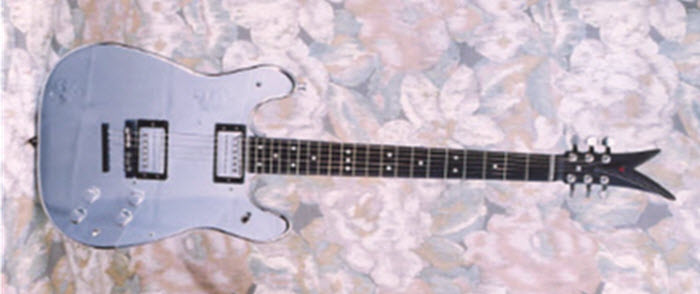
Some guitars are so unique, they acquire something of a “cult status.” I think you could say that about Veleno guitars. Not only have they been played by some famous guitar players (can you say Mark Bolan [T-Rex], Eric Clapton, Jorge Santana, Pete Haycock [Climax Blues Band], Alvin Lee, Ronnie Montrose [Edgar Winter Group], Martin Barre [Jethro Tull], Ace Frehley, Dave Peverett [Foghat], and Mark Farner, just for starters?), they’re pretty darned rare. Not to mention so darned cool!

Vintage 1972 Veleno Standard Electric Guitar
I kind of missed contemporary pop music during the 1970s, with my eyes glued to classical guitar books and my stereo playing old 78 rpm records I found in thrift shops. So, I also missed Veleno guitars, although I did read Guitar Player magazine and thus had a kind of literary idea of what was going on. I probably first learned about Velenos in those pages and, later, when I started building a collection, a Veleno went on my wish list.
I finally located a pair for sale listed in the “want ads” of Vintage Guitar Magazine. I was on the phone two minutes later. A minty gold one was already gone, but this chrome beauty was still available, so I paid what was back then a lot of money to get it.
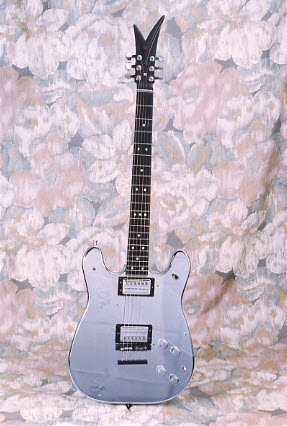
Vintage 1972 Veleno Standard Electric Guitar
The fellow who sold it to me knew where John Veleno was living and I was able to track him down in Florida. That resulted in some interviews that yielded an article in Vintage Guitar Magazine, the chapter in my book Guitar Stories Vol. 2 and subsequent entry in Electric Guitars, The Illustrated Encyclopedia.
John was an amiable fellow who gave me a bunch of great anecdotes. These days I might be a little more critical of some of the facts, but it’s pretty hard to get corroborating data on a small guitar-maker from Florida!
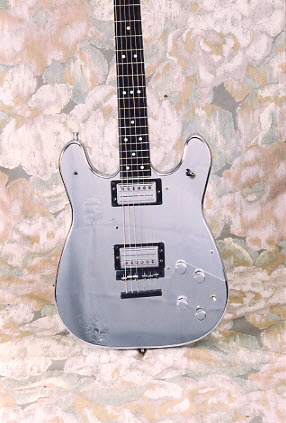
Vintage 1972 Veleno Standard Electric Guitar
John Veleno (b. 1934) was a machinist who grew up in Massachusetts. He started taking guitar lessons in around 1958 and by 1961 he’d become a teacher. If you’ve ever taught guitar, you know it ain’t exactly the most dependable living. Married with children, he became a machinist and relocated to St. Petersburg, Florida, in 1963 and got a job in a machine shop that made aluminum parts for use by NASA at then Cape Canaveral. Veleno augmented his day-job income by giving guitar lessons at home after work. You see where this is going!
Actually, the Veleno guitar originated from some advertising for his teaching sideline. To attract attention to his lessons, John fashioned a guitar-shaped aluminum mailbox for his house. Intrigued by the design, friends urged him to build a real guitar out of aluminum. John bit and Veleno guitars were born.
Using the technology with which he was familiar, Veleno guitars were carved out of aluminum, which was either chromed or anodized—I’m not sure I understand the difference. Most were chrome, but a few were gold, and fewer yet were done in red or blue. Or at least those were offered.
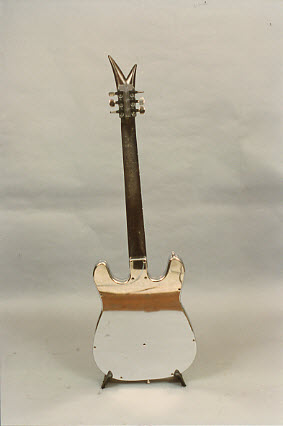
Vintage 1972 Veleno Standard Electric Guitar
If you read my accounts, you’ll find an estimate of around 185 Veleno Originals being made, plus another 10 or so other odd models. That was based on Veleno’s recollection. You’ll find other numbers on the Internet, but they’re all in the same ball-park. Apparently there were some forgeries made, but it’s not clear when that happened; it seems like there was an issue with eBay in the early 2000s. At this writing Veleno was still offering to make you an upgraded version for around $8,000, but, by his own accounting, he’s only made around 10, if that, so Veleno guitars are still relatively rare.
Truth about Velenos is sometimes elusive. Plus John’s accounts were not always crystal clear. He has a massive, rambling “autobiography” you can find with a little searching on the Web. He talks about me in it, accusing me of claiming that he made 3 guitars with bird-shaped heads, wondering where I got that wrong information. Well, guess what? That’s what he told me. He forgot to mention that they were just necks and after Jorge Santana bought a guitar with one, he cut those other heads off. He also claims I got “fired” from my job around 2002, implying some connection that questions my credibility. Actually, I have been fired a couple of times during my advertising career! But, for the record I was laid off at that time and started a very successful agency shortly thereafter which I ran for more than a decade. In any case, it’s all very amusing!
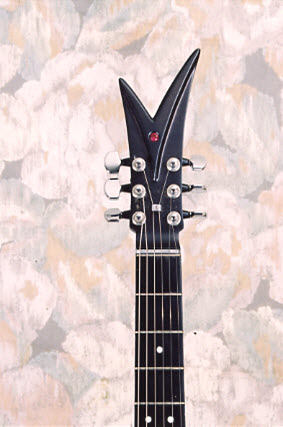
Vintage 1972 Veleno Standard Electric Guitar
This guitar is #90 and features the original Guild humbuckers. The fellow who sold it claimed it had formerly belonged to Frank Hannon of the band Tesla, but there’s no way to verify that. Hannon is on the list of Veleno owners. This guitar was part of the Dangerous Curves exhibition at the Museum of Fine Arts in Boston and it’s in Acoustic Guitars and a host of other books because the photos were subsequently licensed to other publishers (not by me).
Veleno Originals are actually pretty good guitars. They’re light-weight and easy to play. And, if you have one, you’re part of a fairly exclusive club. Like I said, cult objects!

The first time I saw a Veleno guitar was when I saw a picture of Mark Farner (Grand Funk Railroad) playing one. Of course I wondered what kind of guitar was that? It would be nice if someone would resurrect the design and obtain the rights to do so. They must have had great sustain and tuning stability. The Guild humbucking pickups he used were very good having played a S-100 Polara with same from a friend. Thanks for posting the information on a very unique guitar.
re: plated vs. anodized
Plating involves using a current to apply a layer of metal — like the chrome steel bumpers on our old cars. Or gold-plated pickup covers.
Anodizing typically uses current to apply a dye, typically to aluminum.
As you can probably imagine, if all else is equal plating will add considerably more weight than anodizing.
Hey Michael, I love your writing, but shame on you for not mentioning perhaps the most notable Veleno player ever … Todd Rundgren! He had two made for himself, and they actually saw a ton of usage. You’re still the best : )
John Veleno is a senile ass
Hi!
I was in contact with John Veleno about 10 years ago (my words on the guitar is on the official website). I`m also an acquaitance of the late Pete Haycock (Climax Blues Bans, original Veleno player). John threatened to sue me if I ever bought a replica of his original 196 Velenos, he, he … he had quite a temper! I`m a pro mucician (12 albums, live videos …check), and since I´ve been playing- and collecting guitars for years, I´m in the market for an original Veleno to play concerts with … on stage …. Please send us some photo and a few words … Best Ketil Stokkan
I use to own the 50th one and man I really miss that guitar one of the biggest regrets in my life was letting that one go it sounded and played great
Hi,
I wonder how much interest Jeff Lynns (ELO) Chrome Veleno (provenance provided) would produce?
Any idea how much it would be worth?
you can see the guitar being played here…
https://www.youtube.com/watch?feature=player_embedded&v=dZywJO573fg
Feel free to Email me with any interest… thomasmunro@hotmail.co.uk
I had a bandmate who had one of these. There are four things I remember: it was very shiny, it was heavy, it had a cheesy plastic red jewel on the headstock, and after we were onstage at an outdoor festival one sunny day the thing had become so blazingly hot after fifteen minutes that he had the roadie borrow a guitar from another band so that he could finish the set. He said that the time it took to play that number while the roadie was finding another guitar was the most agonizing seven minutes of his life.
In a music store in Union NJ in 1972 hanging on a rack, I bought #17 Veleno for $750. Inside the case was a small brochure that explained the “Corundum Ruby” in the headstock as a “Mark Of Distinction. It also included a short explanation of the guitar and its maker: I wrote a few letters to John, who responded with requests for pics to add to his scrapbook, although I never sent any. I took the guitar when I moved to LA a year later – it was my only guitar. In the mid-late 70’s I again relocated to the DC area and became active in the local bar band scene, and always used my #17. The un-anodized neck was wearing out, and so I bought an anodized neck after speaking with John over the phone. He sounded bad, like he was having health problems. I continued to use the guitar until some of the chrome worn off from pick scratches, and was literally cutting my right hand fingers to the point of bleeding. That’s when I moved on to a Les Paul, then PRS and Strat. #17, in poor condition, remained in its case until around 2006 when I had the funds to have it rebuilt. I contacted John Veleno, who provided an address to send the guitar to which I did, and estimate for a rebuild and refinish. After receiving the guitar, he emailed with several surprising questions, such as “who did you get the anodized neck from”. He later sent back the guitar at my additional cost(not rebuilt) with a detailed letter indicating that the guitar was not authentic, and instead was a forgery. I am now 65 years old. In 1972 I was 20, and I have old band pictures showing me, on stage wearing disco clothes, with my band, playing #17. I was well-known around the DC area as the only guitarist in DC who always played a Veleno. I’m still waiting for the “real #17” to show up, because as of now, it seems to not exist,other than my “fake” Veleno. My question is, who would have built a Veleno clone in 1972 that is seemingly identical to those in the many pictures I’ve seen during the last 45 years? When another #17 pops up, I’ll concede. But until then, I challenge the Veleno crowd to prove the guitar I have is unauthentic.
I agree, Kingster. No one would have faked a Veleno that far back and even if they tried, I doubt they could have done an accurate job. Given there were so few examples in existence at that time to use as a template and so many accurate pictures available today of the small details (such as the bridge), it would be easy to tell if it was a copy. I’ve got a fake that I call a tribute instead of a copy. I had built especially for me and purposely had it made with different specs so no one would be fooled if they even knew a little about real Velenos. In researching my build though, I scoured the web for Veleno pics…and uncovered quite a few pics that are fakes.
I am presently looking for a Veleno for sale. I believe i have found one but with all the talk of fakes makes me nervous about if it is genuine or not. Also what would you consider as a fair price for an authentic one? Any help in any way or if anyone has another they want to sell i would eextremely interested. Thanks
Hey Anthony Favot, I have number 50. Have had it 21 years. If you want to talk, look me up on facebook. Im in Ohio. So sad to see that John just passed away. We talked in July for a long time and I told him I would love to continue our talk,(my battery was running out) but I waited too long. I had written down several things I wanted to ask him about. Look me up.
No.22 is now on sale in japan reuse market.I’m not seller,I just found and curious about whats going on.
https://item.mercari.com/jp/m98986273682/
Brian I’m interested in your Veleno guitar . You can contact me at michaelboogie7777@gmail.com
Johnny Winter told Don Menn in a GP interview (Aug 1974) that he had a Veleno and liked it. Said they had “the thinnest necks in the world.” Also said he couldn’t use it onstage because he had a hard time seeing the fret-position dots under spotlights. (As an albino, Johnny always had vision problems.) He did say that it could have been a good stage guitar if he took the time to get used to it. I can see where it would have appealed to him: Pete Heycock of The Climax Blues Band got some very Firebird-esque slide tones out of his.
the first time I seen one was from Ovaness Agopian from the ban moonquake I believe. ex-guitarist for Michel Pagliaro band the rockers all this in Montreal Quebec Canada at the moustache bar last I heard he was working for some record company so I was told not sure now
How much would no12 Veleno be worth?
I know someone who owns this guitar, they have supporting documents
In 1972 from a music store in Union, NJ I found and bought #17 Veleno for $750. The guitar came with basic paperwork from John Veleno explaining the Corundum Ruby added as a “sign of extinction”. I wrote to John several times over the next few years, with him sharing names of other famous artists who also owned his guitars. He offered to put my photos in his scrapbook. Several years later I ordered from John the anodized black neck to replace to naked aluminum neck that had basically worn out from professional use. This was my only guitar used for over 2000 gigs until the mid 80’s, until I literally wore it out. I have old band pics showing me and the guitar. I was the only known guitarist in the DC area gigging a Veleno, and I was known for that guitar. By early 80’s, I’d replaced the Veleno with a Les Paul, and the Veleno stayed in its case until around 2006 when I decided to have it refurbished by John. I contacted him and John said to send it down where he would do the work. He also said he would appraise it, which I hadn’t thought about but welcomed the input. After he had the guitar for a week, he emailed me asking odd questions: “Where did you get that neck”, as if he was suspicious. He then sent back (cod) the guitar with a detailed description as to why this guitar was an imitation likely made within the past decade, and therefore accusing me of fraud. He didn’t refurbish anything. Looking at the various lists of the whereabouts of Veleno guitars by serial number, I have yet to see #17. When I contacted John to buy the anodized neck in the 80’s, he sounded horrible and had had a stroke. My sympathies, but he’s obviously lost his rationality, and I’m not a fraud.
Allow me to critique Veleno guitars as professional working instruments:
1) The all aluminum body and neck are susceptible to wild changes in temperature, such as when taking 20-minute gig breaks. This affects tuning that requires a fresh tune at the beginning of each set while the guitar is cold, then after about 10 minutes of playing when the guitar warms up.
2) The aluminum nut is soft enough that steel strings cut into it and cause the strings to stick and whack tuning out.
3) The string pull-down nut also causes sticking.
4) The poor neck design also fails to let the strings follow a straight path to the tuning pegs which causes even more sticking.
Although I got used to strapping on a cold, metal guitar each set, when I switched to a warm, wooden Les Paul that stayed in perfect tune night after night, I never looked back.
Veleno guitars are rare and as such have a collectors value, but as practical guitars they fail miserably. Artists who have tried to use these guitars as a primary instrument have quickly learned this, and that’s why you rarely see anyone using these guitars on stage.
Hi Gary. I was the soundguy/roadie and now what is called a ‘guitar tech’ for Climax Blues Band in the 70’s ! So I became quite intimate with Veleno guitars. Pete Haycock had 3, The ‘gold plated one was no.14, the chrome plated one was no.51 and the 1/2 scale ‘baby’ was no.1 I changed the neck at a gig in Florida in about ’77(?)when John Veleno brought another one for Pete to try. I think it was a ‘Teflon’ coated one if I remember, anyway it was darker than the original neck which I still have in my workbox! I changed the neck after soundcheck and before the show. 4 set screws was all it took. There was no ‘set up’ involved it came up perfect as of course it was made by a master machinist! Once on stage with the guitar Pete did any tuning as was necessary. Rotosound Strings mainly as I was an ‘endorsee’ but Ernie Ball 009 on the top E.I did change picks up to DiMarzio on the chrome one as they were the fashion at the time, I still have the old chrome pick up as well. Pete used all three guitars every night and only changing to a Firebird occasionally or a lap steel , he would not have done if they were a problem. I guess each to his own!